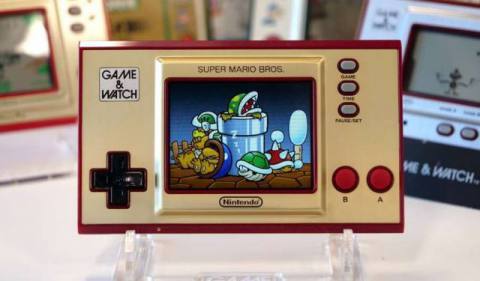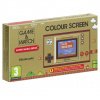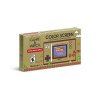Looking back on the history of Nintendo as a maker of video games, it’s clear that the Game & Watch line was a significant step; not only did it allow Nintendo’s core developers to hone their skills with snappy, engaging titles, it also gave them the opportunity to evolve their hardware talents, coming up with innovations such as the famous ‘cross’ D-Pad and dual-screen play – innovations which would influence the entire industry, as well as future in-house projects, like the DS and 3DS.
Another equally important moment in Nintendo’s history was the arrival of Super Mario Bros. in 1985, the game which – alongside Donkey Kong – is arguably responsible for establishing the Japanese company as a major player in the world of interactive entertainment. Given that 2020 is the 40th birthday of the Game & Watch and the 35th birthday of the game that took plain old Mario and made him super, it makes sense that Nintendo has chosen to celebrate it not only with another re-release of the famous NES title (is it possible to have too many ports of Super Mario Bros. in your home?), but one that also pays homage to the earlier success of the seminal Game & Watch line.
It makes sense that Nintendo has chosen to celebrate Super Mario Bros. not only with another re-release of the title, but one that also pays homage to the earlier success of the seminal Game & Watch line
If you’re over the age of 40, then you’ll instantly appreciate the packaging Game & Watch: Super Mario Bros. comes in, which is based on the box designs of the Game & Watch line from the early ’80s. The unit itself is roughly the same size as the initial wave of single-screen Game & Watch titles, and feels just as robust and study. However, Nintendo is wisely not relying entirely on nostalgia to sell this thing; those who weren’t even born when the final Game & Watch model, Mario The Juggler, arrived in October 1991 will still want to get their hands on this device because it’s highly collectable and looks great sitting on a shelf (it’s also likely to rise in value over time, as Nintendo has stated that it’s a limited release).
The unit adopts the same colour scheme as the Japanese Famicom, and consists of a plastic shell with a golden metal front plate – another recognisable hallmark of the original Game & Watch line. The iconic cross D-Pad – which began life on the Donkey Kong Game & Watch dual-screen model from 1982 – is present and correct, alongside two rubber action buttons (again, another callback to the controls on the original machines). Three option buttons are located on the front as well; one allows you to select between the three games (Super Mario Bros., the Japanese Super Mario Bros. 2 and a version of Ball, the very first Game & Watch title from 1980), while another drops you to an animated clock. The third allows you to pause the game and toggle elements such as screen brightness and volume, as well as reset the current game.
Unlike many of the original Game & Watch units, there’s no kickstand on the back – a disappointing oversight when you consider that the unit can be used as a clock. In fact, outside of the serial number and the usual compliance notices, the rear is relatively plain – there’s no battery compartment, as was seen on the originals because the unit is powered by an internal rechargeable battery which is topped up using the USB-C cable included in the box (the charging port is located on the right-hand side of the unit, next to the power button). Battery life is estimated to be around 8 hours, although if you have the screen on full brightness and volume set to maximum, you should expect less. The only other element of note is the mono speaker, which is found on the left-hand edge of the device.
The unit’s colour LCD screen is bright and colourful, but because it’s not displaying the exact native resolution of the NES, it does give the visuals a somewhat soft quality
Because the layout of the unit is such a close match to the NES controller, playing these games is a breeze; if we had any criticism, it would be that the D-Pad is positioned a little too close to the bottom edge of the device, but this is a minor quibble. The pad itself is super-responsive and a joy to use; the rubber buttons might feel odd to those accustomed to hard plastic, but they possess a nice, grippy texture which prevents your sweaty thumbs from slipping off them during intense play.
The unit’s colour LCD screen is bright and colourful, but because it’s not displaying the exact native resolution of the NES, it does give the visuals a somewhat soft quality. Viewing angles are mostly decent, too; it’s only when you tilt the until downwards towards yourself that the image begins to invert its colours slightly, but when tilted in any other cardinal direction, the screen remains perfectly legible. The single speaker is pretty loud, too, when you consider that it’s side-mounted and rather dinky – there’s no 3.5mm headphone jack, however.
Given that we’re talking about games that are now over 35 years old, it should come as no shock to learn that the software emulation is rock-solid, right down to the way that parts of the background music drop out to make way for sound effects at certain points due to the limited number of sound channels the NES possesses. Another nice touch is the fact that your progress is retained in-game even when you switch the unit off or toggle to another title, allowing you to pick up from where you left off later on if you decide the Mushroom Kingdom is getting boring and you fancy a quick go on Ball.
Nintendo has made much of the fact that the unit’s animated clock – which shows Mario dashing through an enemy-filled scene from the game, with the time shown in blocks – comes with 35 hidden secrets (one of which, the ‘Mario Drawing’ song, has already been ruined due to the fact that it showcases a language error), and there’s definitely an element of fun to be had discovering new hidden elements. Some of these secrets are relatively simple (pressing the A and B buttons simultaneously causes the blocks to glow, for example, while another secret sees Mario perform a Michael Jackson-style moonwalk) but others are more dramatic and actually change the scene Mario is in altogether. We also love the way the unit has several special ‘sleep’ screens which appear just before it powers down after being left unattended for a short time.
Why choose to limit the game’s library to just these three titles, when we know for sure that it’s possible to include a whole host of NES ROMs?
From a hardware perspective, then, Game & Watch: Super Mario Bros. is a lovely little device which runs three games very well indeed – but that leads us to the single biggest problem we have with such a product. Why choose to limit the game’s library to just these three titles, when we know for sure that it’s possible to include a whole host of NES ROMs? Super Mario Bros. is a stone-cold classic, that much is clear, but it would have been nice to have a few more Mario outings included, such as the North American sequel and even the third legendary NES instalment, which ranks as one of the greatest 8-bit games of all time. Super Mario Bros. 2 – also known as The Lost Levels – might be something of a curiosity for western players, but it’s basically a harder expansion of the original game and arguably isn’t as interesting as the western sequel (which, as any Nintendo bore will tell you, isn’t a real Mario game at all, but a reskinned version of the Famicom title Yume Koujou Doki Doki Panic). And why not include a few more Game & Watch titles? Ball is a nice way to reference the history of this handheld range, but it would have been nice to see other games – such as the Game & Watch version of Super Mario Bros. from 1986, for example.
It’s highly likely that Nintendo plans to create more of these commemorative Game & Watch units as the anniversaries roll in – and, given that both The Legend of Zelda and Metroid turn 35 next year, it’s fair to say we’re about to enter a period in which Nintendo can comfortably roll at least one of these out every 12 months. Never a company to turn down the opportunity to make cold, hard cash by squeezing its fanbase, it’s perhaps naive of anyone to expect Nintendo to release a device like this and pack it to bursting point with games, but even so, when you’re paying £50 for a trio of ROMs which are available elsewhere already, it does seem rather tight-fisted, even by Nintendo’s often Scrooge-like standards.
Will our complaints matter, though? Probably not. The unit has apparently been selling briskly, and we dare say it will be finding its way into many a Christmas stocking come the end of December. On paper, at least, it’s the ideal gift for gamers old and young alike thanks to the way it bridges the generations; if you’re old and remember the Game & Watch handhelds, then you’ll love the nostalgia factor, and if you’re young, seeing Mario’s early adventures unfold in their 2D glory will certainly be of interest. We can only hope that with the next Game & Watch release – which surely has to be Zelda-related – Nintendo decides to include a little bit more content. If not, then there’s always the inevitable hack, of course.
Please note that some external links on this page are affiliate links, which means if you click them and make a purchase we may receive a small percentage of the sale. Please read our FTC Disclosure for more information.



